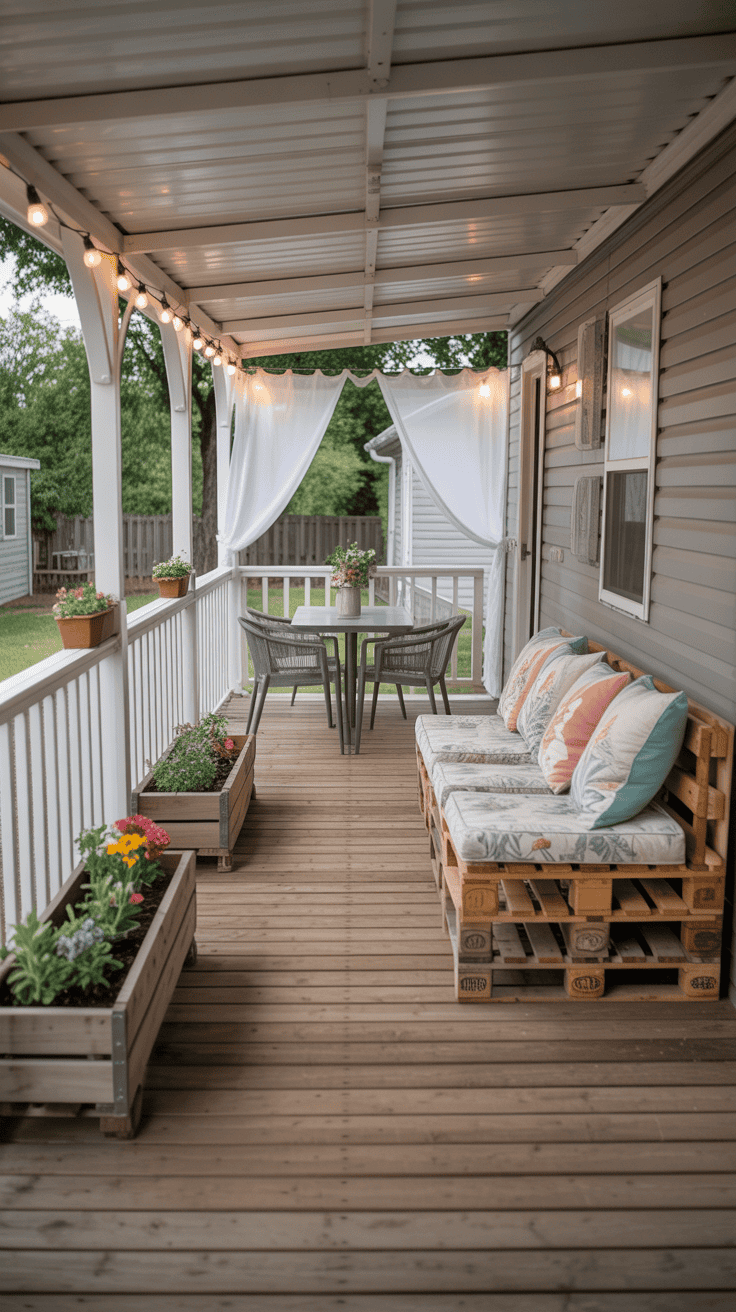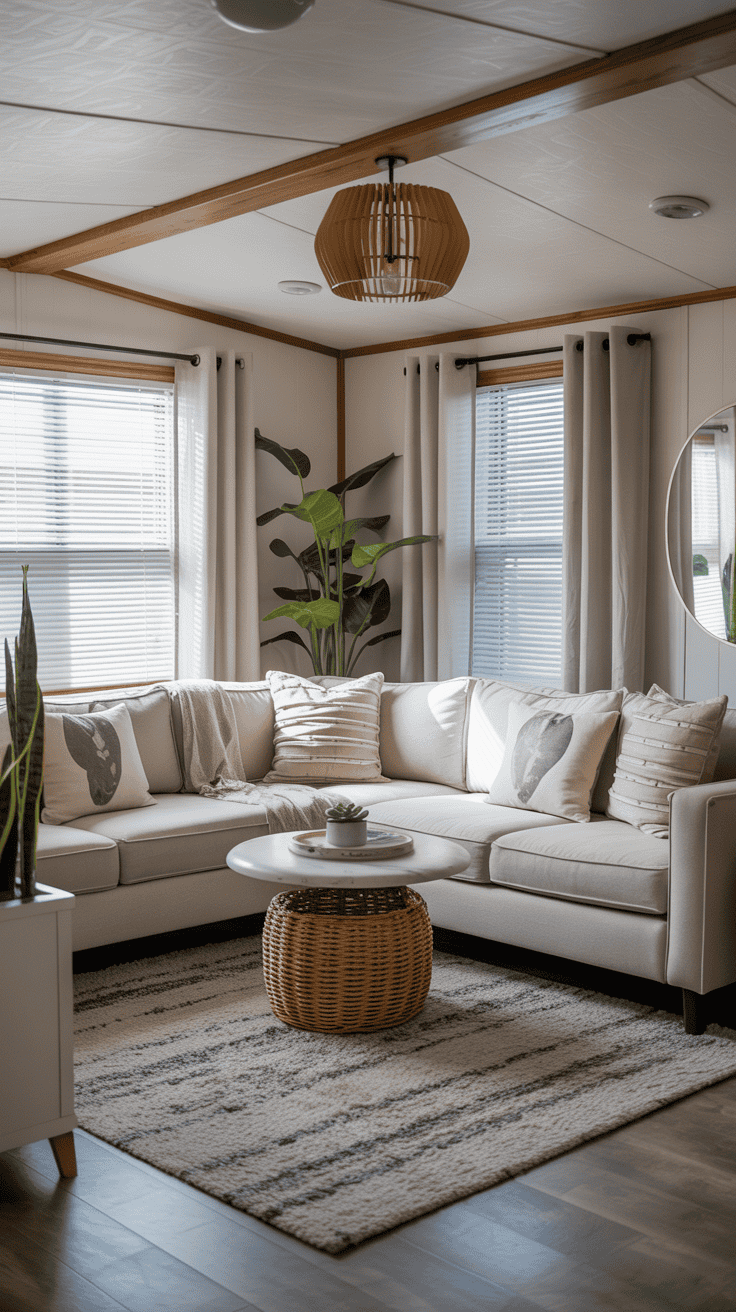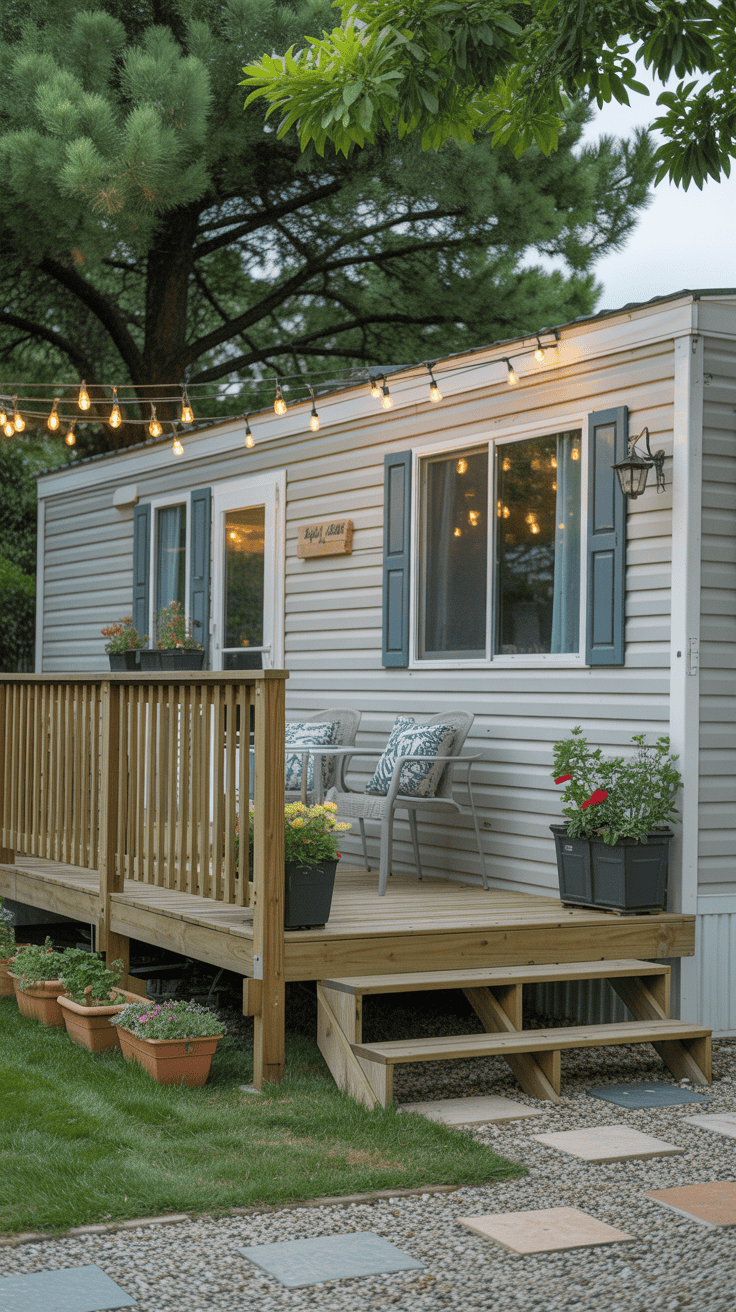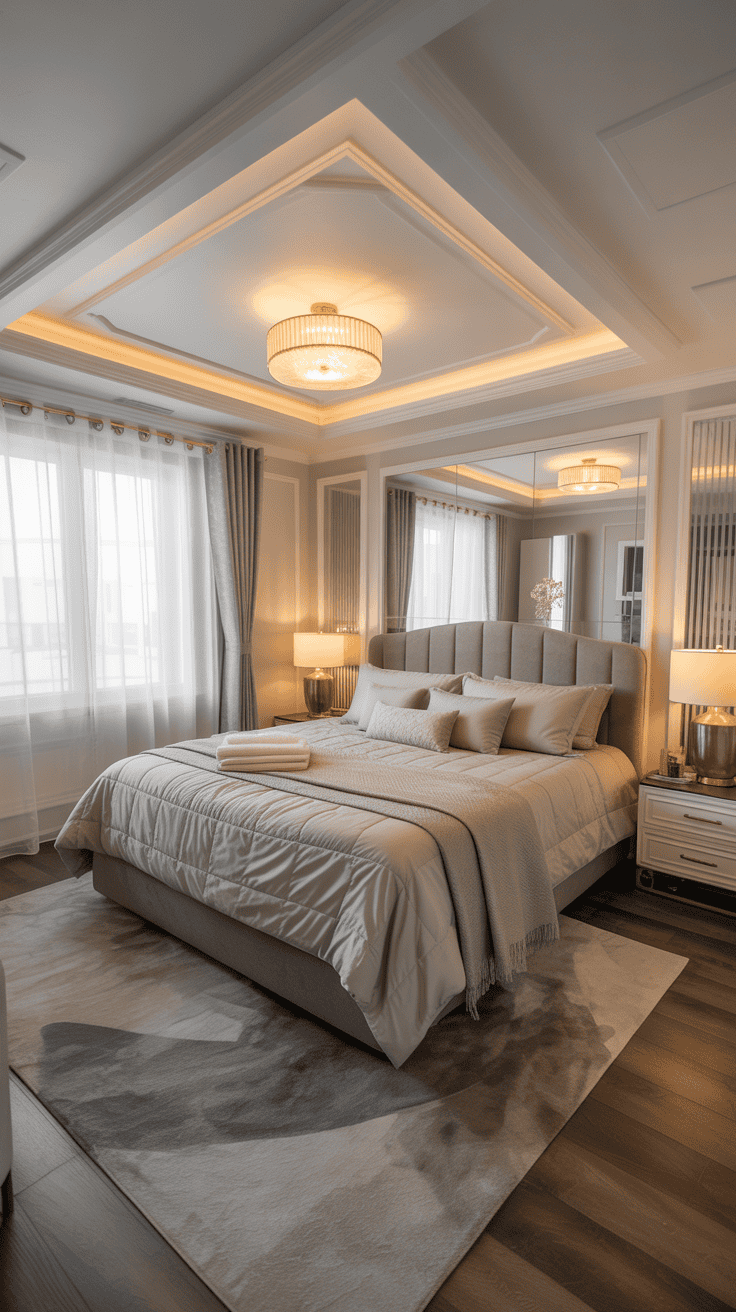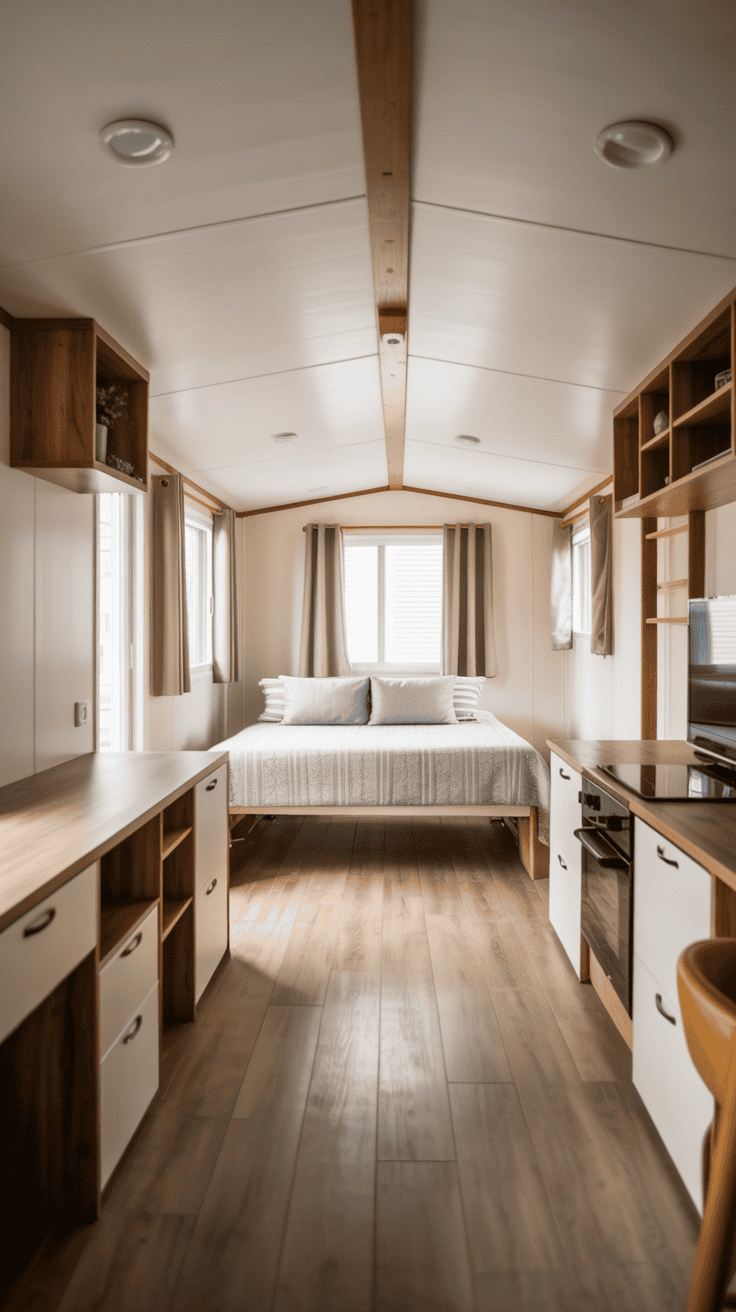This post shows 10 Budget-Friendly Mobile Home Back Porch Ideas!
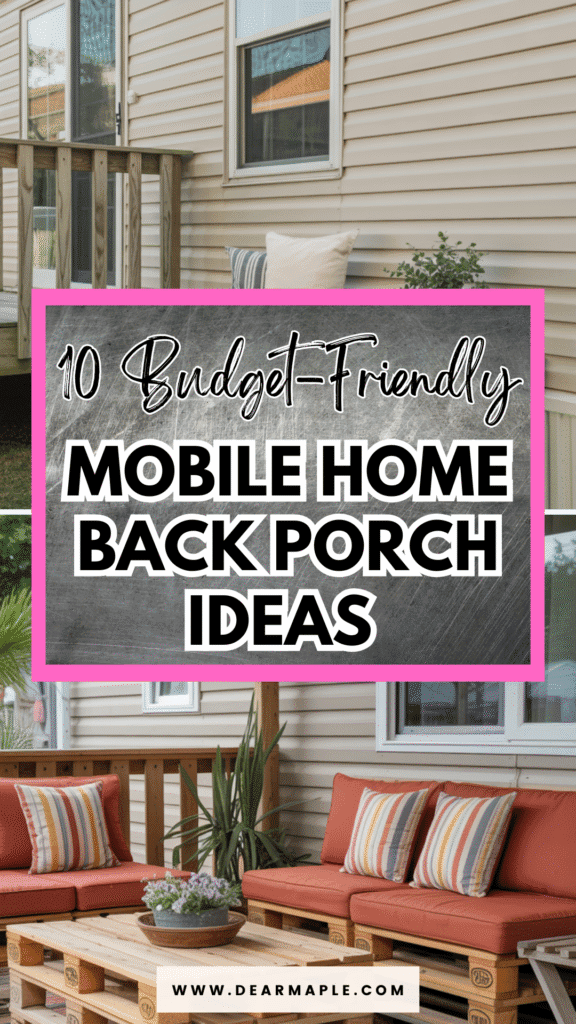
You know what? Your mobile home’s back porch doesn’t have to look like a sad afterthought. I’ve seen too many beautiful mobile homes with porches that scream “we gave up” – and honestly, it breaks my heart a little. Here’s the thing: you don’t need to blow your entire savings account to create an outdoor space that’ll make your neighbors do a double-take.
I’ve been transforming outdoor spaces on a shoestring budget for years, and let me tell you, mobile home porches have some serious potential. The key is working smart, not hard – and definitely not expensive. Whether you’re dealing with a tiny concrete slab or a decent-sized deck, these ten ideas will help you create an outdoor oasis without requiring a second mortgage.
10 Budget-Friendly Mobile Home Back Porch Ideas
1. Create a Cozy Seating Area with Pallets
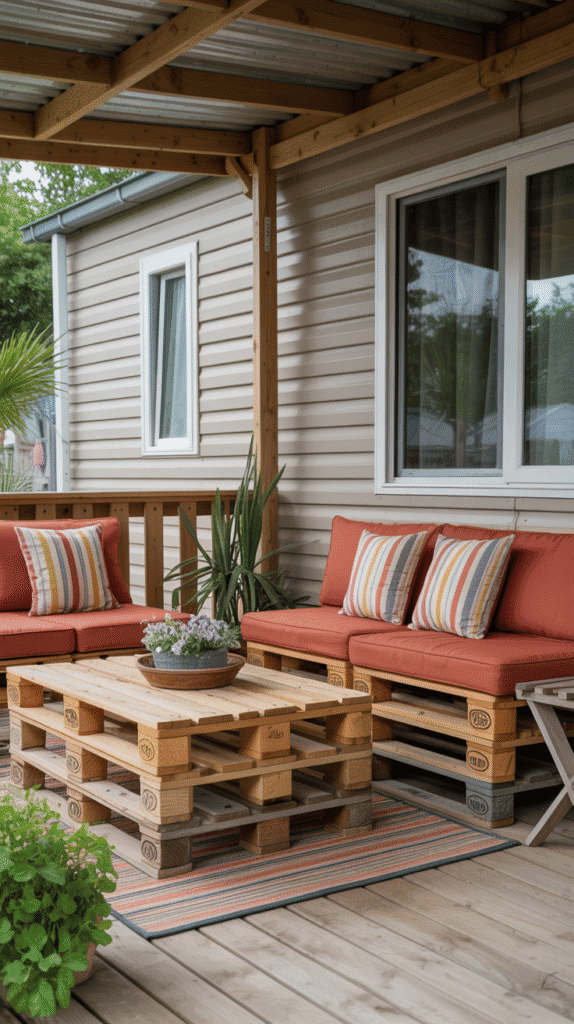
Let’s start with the MVP of budget furniture: wooden pallets. I’m not even kidding when I say pallets are basically free furniture waiting to happen. You can usually snag them from local businesses, construction sites, or even post on Facebook asking if anyone has extras lying around.
Here’s how I turn these industrial castoffs into cozy seating. First, you’ll want to sand them down – trust me, splinters and relaxation don’t mix. A basic orbital sander will do the trick, or you can go old school with sandpaper if you’re feeling ambitious. Once they’re smooth, stack two pallets for the perfect seat height, and boom – you’ve got the base for a sectional sofa.
The magic happens with the cushions. Hit up discount stores or wait for end-of-season sales to grab outdoor cushions. I’ve found amazing deals at places like Big Lots and even Walmart clearance sections. Pro tip: wrap regular indoor cushions in waterproof covers if you’re really pinching pennies.
For the back support, you can either lean the pallets against your home’s wall or create a proper backrest by attaching another pallet vertically. Add some colorful throw pillows, and suddenly your porch looks like it belongs in a home decor magazine. The total cost? Usually under $100 for a full seating area that seats 4-6 people comfortably.
2. Install String Lights for Ambient Lighting
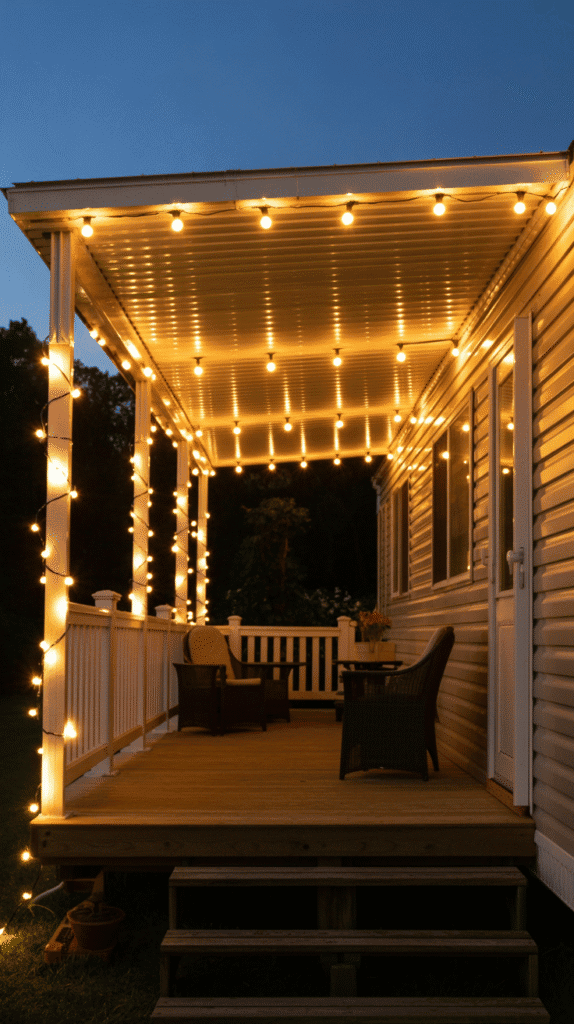
Ever wonder why restaurants use dim lighting? Because it makes everything look better – including your porch! String lights are absolutely magical for creating that cozy, Instagram-worthy vibe without spending a fortune.
I’ve experimented with different types over the years, and here’s what I’ve learned. LED string lights are your best friend. They last longer, use less electricity, and won’t heat up like those old incandescent bulbs. You can find decent sets at dollar stores, but honestly, spending $15-20 on a quality set from Home Depot or Amazon will save you headaches later.
Installation is where you can get creative. I like to create a canopy effect by stringing lights from corner to corner, then adding some zigzag patterns for visual interest. Tension is key – nobody wants saggy lights that look like they’re giving up on life. Use small hooks screwed into your home’s siding or the porch ceiling, and consider adding a dimmer switch if you’re feeling fancy.
For mobile homes, pay attention to your electrical setup. Most porches have at least one outlet, but you might need a heavy-duty outdoor extension cord. FYI, always use outdoor-rated cords and lights – indoor lights outside are just asking for trouble. The whole setup should cost you less than $50, and the ambiance? Priceless.
3. Build a Simple Planter Box Garden
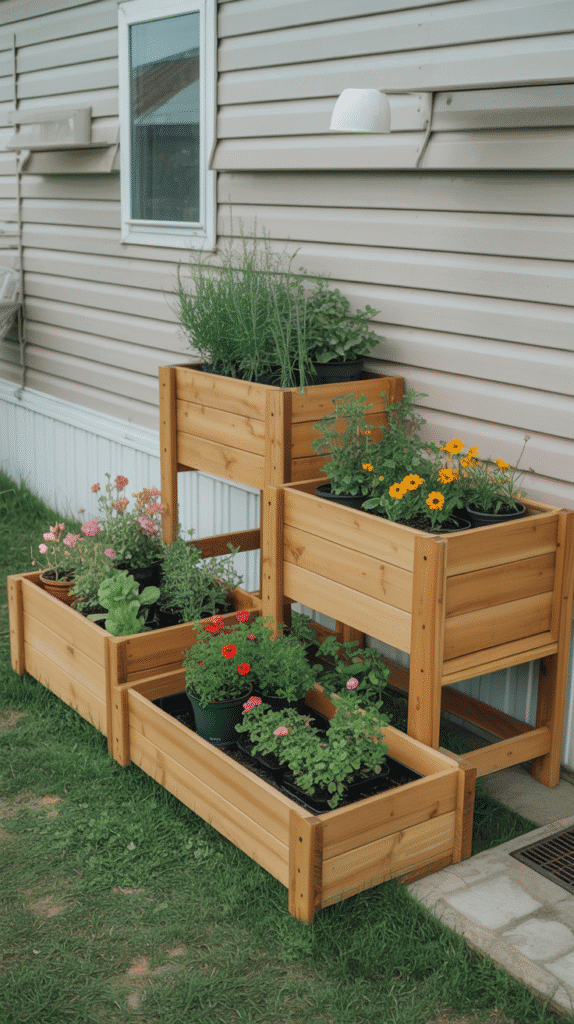
Nothing transforms a space quite like living greenery, and planter boxes are perfect for mobile home porches where you can’t exactly plant directly in the ground. I love this approach because you can move things around, control the soil quality, and honestly, it just looks more intentional than random pots scattered everywhere.
Building basic planter boxes is surprisingly simple. You’ll need some 2×8 lumber, deck screws, and a drill. I usually make mine about 2 feet wide and 8-10 inches deep – enough for most plants but not so deep that they become back-breaking to move. Cedar is worth the extra cost if you can swing it, since it naturally resists rot and insects.
Here’s where plant selection gets fun. For low-maintenance options, I’m obsessed with succulents and herbs. Succulents basically ignore you and still look amazing, while herbs give you something useful for cooking. If you want flowers, marigolds and petunias are practically bulletproof and bloom all season long.
The beauty of planter boxes is seasonal flexibility. Spring lettuce and peas, summer tomatoes and peppers, fall mums and pumpkins – you can completely change your porch’s personality four times a year. Budget-wise, you’re looking at about $30-40 per planter box, and seeds or small plants add maybe another $20. Not bad for a complete garden makeover!
4. Add Privacy with Outdoor Curtains

Privacy can be tricky with mobile home porches, especially if your neighbors are, let’s say, enthusiastic about keeping tabs on everyone’s business :/ Outdoor curtains solve this problem while adding serious style points to your space.
The key is choosing the right fabric. Outdoor fabric is specifically designed to handle sun, rain, and whatever else Mother Nature throws at it. I’ve made the mistake of using regular indoor curtains outside – they faded faster than my motivation on Monday mornings. Marine-grade vinyl, canvas, and specially treated polyester fabrics are your best bets.
Installation is easier than you think. Tension rods work great if you have a covered porch with a ceiling. For open porches, you can install curtain rods directly to your home’s siding using heavy-duty brackets. I like to hang them high and wide to make the space feel larger and more dramatic.
Color and pattern choices can make or break this look. Solid colors tend to look more sophisticated, while stripes can make your porch feel like a fancy resort cabana. I’ve found that darker colors hide dirt better but can make small spaces feel cramped. Light colors reflect heat, which is awesome in summer but might show every speck of dust.
The whole project usually runs $60-80 depending on your porch size, and the privacy payoff is immediate. Plus, you can tie them back when you want an open feel or close them for intimate evening gatherings.
5. Create Shade with a DIY Pergola or Awning

Shade is everything on a mobile home porch, especially during those brutal summer afternoons when the sun turns your outdoor space into a furnace. A DIY pergola might sound intimidating, but it’s basically just a fancy framework – and you can absolutely build one without advanced carpentry skills.
For a basic pergola, you’ll need pressure-treated lumber, galvanized bolts, and some basic tools. I usually go with 2×6 rafters spaced about 16 inches apart for good shade coverage. The key is proper anchoring – mobile homes require special consideration since you can’t just dig post holes like you would for a traditional foundation.
Instead, I recommend using surface-mount post anchors that bolt directly to your porch deck. These distribute the weight properly and won’t compromise your home’s structure. If you’re not comfortable with the structural aspects, hire a handyman for the installation – it’s worth the peace of mind.
For those wanting something less permanent, retractable awnings or shade sails are fantastic alternatives. Shade sails especially have that modern, architectural look that can make your mobile home porch look incredibly current. You can find quality shade sails online for $30-50, and installation just requires some eye bolts and turnbuckles.
The pergola route will cost you $200-300 in materials, while shade alternatives run $50-100. Either way, you’ll drop the temperature on your porch by 10-15 degrees and create a space you actually want to use during the day.
6. Install Artificial Turf or Outdoor Rugs

Let’s be honest – mobile home porch flooring isn’t always the prettiest. Concrete slabs and basic decking can look pretty institutional, but you can completely transform the space with the right flooring treatment.
Artificial turf has come a long way from the stuff that looked like green carpet. Modern artificial grass actually looks and feels realistic, and it’s perfect for porches because it drains well and requires zero maintenance. I’ve used it on several projects, and guests always do a double-take wondering if it’s real.
Installation is straightforward. You’ll need outdoor adhesive or double-sided tape designed for artificial turf. Measure twice, cut once – this stuff isn’t cheap to replace if you mess up. Most artificial turf comes in 6 or 12-foot widths, so plan your layout accordingly.
If artificial turf feels too bold, outdoor rugs are an excellent middle ground. They come in amazing patterns and colors, and you can easily switch them out seasonally or when you get bored. I’m partial to geometric patterns that hide dirt but still add visual interest.
Maintenance is minimal for both options. Artificial turf just needs occasional hosing off, while outdoor rugs can be shaken out or even pressure washed if they get really grimy. Budget-wise, artificial turf runs $3-5 per square foot, while good outdoor rugs range from $50-150 depending on size. Either option will completely change how your porch feels underfoot.
7. Build Multi-Level Plant Stands

Vertical space is your friend when you’re working with a mobile home porch. Multi-level plant stands let you create a lush garden paradise without eating up precious floor space – and honestly, they look way more intentional than plants scattered around randomly.
I love building tiered plant stands because you can customize them to fit your exact space and style. Basic lumber and some creativity go a long way here. You can create simple ladder-style stands, corner units that maximize awkward spaces, or even hanging versions that attach to your porch railings.
For the DIY approach, pressure-treated 2x4s work great for the frame, with 1×6 boards for the shelves. Spacing is crucial – you want enough room between levels so upper plants don’t block sunlight from lower ones. I usually go with 12-15 inches between levels, which accommodates most pot sizes.
Plant selection becomes an art form with tiered displays. Put sun-loving plants on top levels and shade-tolerant ones below. I like to mix textures and heights – trailing plants like petunias or ivy on the edges, upright plants like geraniums in the middle, and maybe a small shrub or tall grass as an anchor point.
If building isn’t your thing, you can achieve the same effect with stacked planters or even repurposed ladders and crates. The key is creating visual layers that draw the eye upward. Total cost usually runs $40-80 depending on size and materials, but the impact on your space is enormous.
8. Add Functional Storage with Weather-Resistant Containers

Storage is always a challenge with mobile home living, and your porch can actually help solve this problem while looking good. Smart storage solutions kill two birds with one stone – they keep your space organized and provide extra seating or surface area.
Deck boxes are the obvious choice, but I love getting creative with storage. Large ceramic planters can hide garden tools and supplies. Wicker baskets with waterproof liners work great for cushions and outdoor games. Even repurposed coolers can serve double duty as storage and extra seating.
The key is choosing weather-resistant materials. Plastic gets a bad rap, but modern resin storage boxes look surprisingly good and can handle any weather Mother Nature throws at them. If you prefer natural materials, make sure wood is properly sealed and metal won’t rust.
Organization is everything with porch storage. I like to designate specific containers for different purposes – one for garden supplies, another for outdoor entertaining essentials, maybe one for seasonal decorations. Clear containers or labels help you find things quickly instead of digging through everything.
Location matters too. Place storage where it makes sense functionally but doesn’t block traffic flow or create visual clutter. I often use storage containers as side tables next to seating areas or as plant stands for larger containers. The whole storage system should cost $100-200 depending on your needs, and the organization payoff is immediate.
9. Create a Dining Space with a Compact Table Set

Outdoor dining changes everything about how you use your porch space. There’s something magical about eating meals outside, even if it’s just your morning coffee or a quick lunch. The trick is finding furniture that fits your space without overwhelming it.
For mobile home porches, scale is crucial. A massive dining set will make your space feel cramped and awkward. I prefer bistro-style tables that seat 2-4 people comfortably. Round tables work better than rectangular ones in tight spaces because there are no sharp corners to navigate around.
Folding furniture is brilliant for small porches. You can set up a full dining area when you need it and fold things away when you want more open space. I’ve found some amazing folding sets at discount stores and even garage sales – sometimes you just need to give them a fresh coat of outdoor paint.
Material choices matter for longevity. Metal furniture lasts forever but can get hot in direct sunlight. Plastic is lightweight and affordable but might not have the look you want. Wood is beautiful but requires more maintenance. IMO, powder-coated aluminum hits the sweet spot of durability, looks, and reasonable cost.
Don’t forget about weather protection. Furniture covers are cheap insurance against sun fade and rain damage. Even better, choose a spot that gets some natural protection from your home’s overhang or nearby trees. A decent compact dining set should run $150-300, and the lifestyle upgrade is worth every penny.
10. Install Decorative Lattice Panels for Style and Function
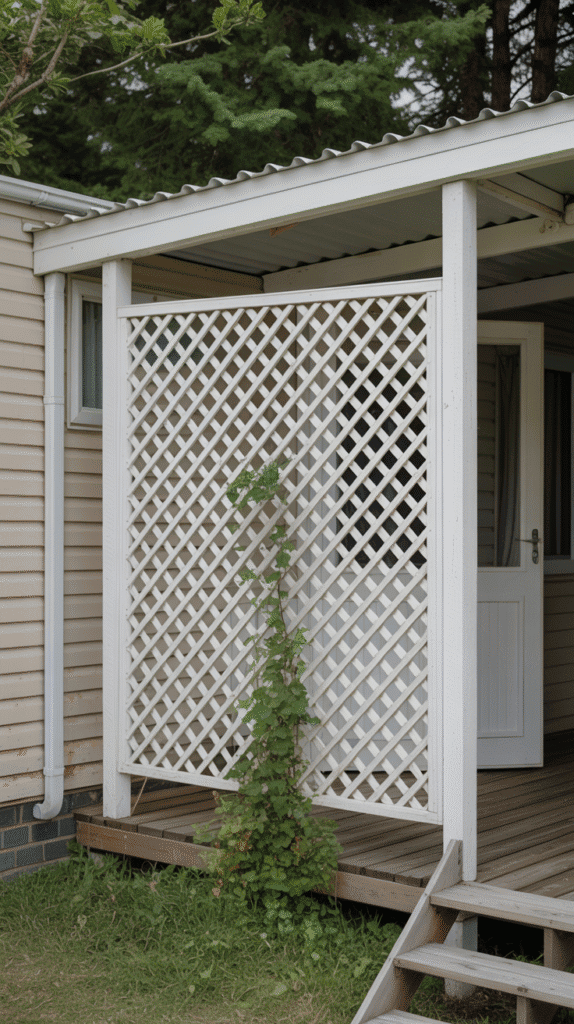
Lattice panels are seriously underrated for mobile home porches. They add instant architectural interest, provide privacy screening, and give you something to hang plants or lights from. Plus, they’re relatively inexpensive and easy to install.
I love using lattice to create defined zones on larger porches. You can separate a dining area from a lounging area, or screen off a corner for storage without building permanent walls. The visual impact is immediate – suddenly your porch feels more like an outdoor room instead of just a deck.
Installation options are flexible. You can attach panels directly to your home’s siding, mount them between posts, or even create freestanding screens with a simple frame. For mobile homes, I usually recommend surface mounting with appropriate anchors rather than trying to dig post holes.
Plant integration is where lattice really shines. Climbing plants like morning glories, clematis, or even simple pole beans turn plain lattice into a living wall. If you’re not into gardening, artificial greenery can give you the look without the maintenance – and modern fake plants look surprisingly realistic.
Customization is easy with lattice. Paint or stain it to match your home’s trim, or go bold with a contrasting color that makes it pop. You can even weave ribbon or outdoor fabric through the openings for added color and texture. A basic lattice panel setup usually costs $50-100, but the visual impact and functionality are worth much more.
Wrapping It All Up
Look, transforming your mobile home’s back porch doesn’t require winning the lottery or having HGTV-level skills. These ten ideas prove that creativity beats cash every single time. I’ve seen people spend thousands on outdoor spaces that have less personality than what you can create with a few hundred dollars and some weekend effort.
The best part? You don’t have to tackle everything at once. Start with string lights and a few plants, then add elements as your budget and energy allow. Each improvement builds on the others, creating a space that feels intentional and welcoming.
Your porch should reflect your personality and serve your lifestyle. Love entertaining? Focus on seating and dining areas. Prefer quiet mornings with coffee? Create a cozy corner with plants and soft lighting. There’s no wrong way to do this – just your way.
So grab a cold drink, head out to your porch, and start dreaming. Your outdoor oasis is waiting, and honestly, your neighbors are going to be a little jealous when you’re done 😉
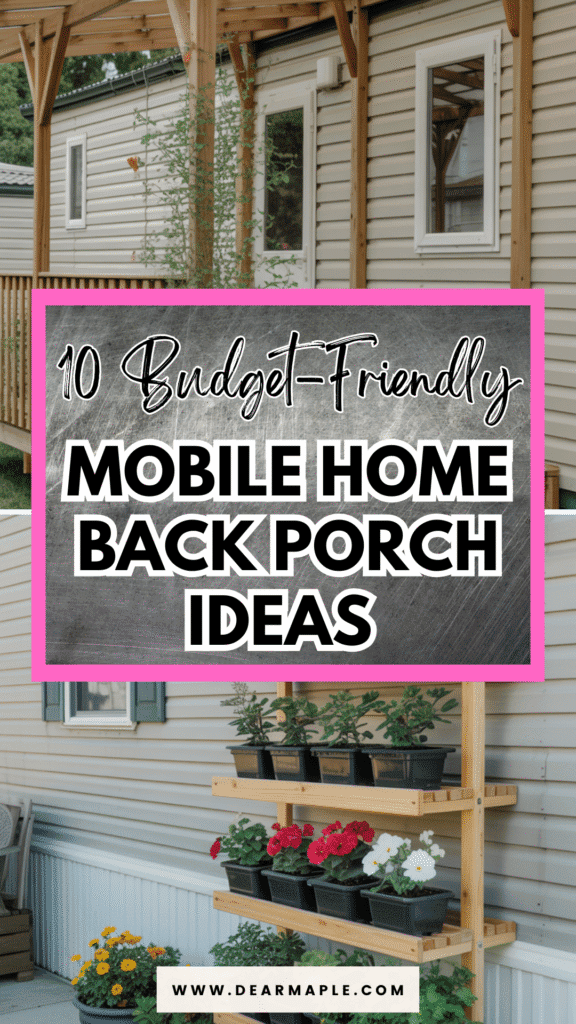
This post shows 10 Budget-Friendly Mobile Home Back Porch Ideas!

